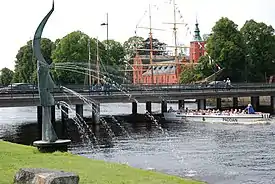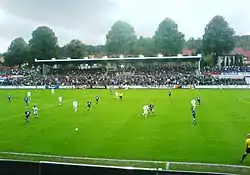Halmstad
Halmstad (Swedish: [ˈhǎlmsta(d)] (![]() listen))[2] is a port, university, industrial and recreational city at the mouth of the Nissan river, in the province of Halland on the Swedish west coast. Halmstad is the seat of Halmstad Municipality and the capital of Halland County. The city had a population of 70,480 in 2019,[1] out of a municipal total of over 100,000 (19th most populous — 2019). Halmstad is Sweden's 19th-largest city by population and located about midway between Gothenburg (the second most populous) and Malmö (the third). Timber framing architecture is common.
listen))[2] is a port, university, industrial and recreational city at the mouth of the Nissan river, in the province of Halland on the Swedish west coast. Halmstad is the seat of Halmstad Municipality and the capital of Halland County. The city had a population of 70,480 in 2019,[1] out of a municipal total of over 100,000 (19th most populous — 2019). Halmstad is Sweden's 19th-largest city by population and located about midway between Gothenburg (the second most populous) and Malmö (the third). Timber framing architecture is common.
Halmstad | |
|---|---|
   | |
 Coat of arms | |
 Halmstad  Halmstad | |
| Coordinates: 56°40′26″N 12°51′26″E | |
| Country | Sweden |
| Province | Halland |
| County | Halland County |
| Municipality | Halmstad Municipality |
| Area | |
| • Total | 36.68 km2 (14.16 sq mi) |
| Elevation | 11 m (36 ft) |
| Population (2019)[1] | |
| • Total | 70,480 |
| • Density | 1,921/km2 (4,980/sq mi) |
| Time zone | UTC+1 (CET) |
| • Summer (DST) | UTC+2 (CEST) |
| Postal code | 30x xx |
| Area code | (+46) 35 |
| Website | www |
History
Halmstad, at the time part of the Kingdom of Denmark, received its first city charter in 1307, and the city celebrated its 700th anniversary in 2007. The oldest remains of that first town are to be found at "Övraby" upstream on Nissan, just south of and quite close to the present day regiment buildings. The remains of the church can still be seen today between a defunct brick industry and a former landfill.
In the 1320s the town moved to the present day town centre. At this time there were two monasteries in the town and during the 15th century the St. Nikolai church was built. Halland was the object of numerous battles, sieges and occupations by Swedish troops.
During the Kalmar Union — a Nordic Union between Sweden, Norway and Denmark which lasted between 1397 and 1523 – it was in Halmstad that the Union King was to be finally selected.
At the end of the 16th century Christian IV of Denmark ordered the fortification of Halmstad and in the beginning of the 17th century to build a crescent-shaped fort with Nissan as part of the defences.
1619 is an important date in the history of Halmstad. In March of that year, King Gustav II Adolf of Sweden and Christian IV met at the castle. Over a period of a week they celebrated the payment in full of the Älvsborg ransom. August of the same year saw the destruction of Halmstad by fire.
Halland became part of Sweden for a period of thirty years when peace was declared at the Treaty of Brömsebro in 1645 and Danish rule ended. The Treaty of Roskilde in 1658 made this acquisition permanent. Sweden defeated Denmark in the Battle of Fyllebro which took place in 1676 just outside Halmstad. In 1678, a parliamentary meeting (Riksdag) was held in Halmstad.
The Riksdag decided in 1734 that the city's fortifications would be demolished. Some residues of fortifications have been preserved, including one of the four city gates, Norre Port. For a period, the old fortifications were used for tobacco cultivation.
The city's first major industry, Wallbergs Factory AB was built in 1823. The brewery Appeltofftska (now Krönleins) was founded in 1836 and brewery Östra Bryggeriet in 1846. AB Malcus Holmquist, also called Malcus, was formed in 1902. Nordiskafilt AB started in 1904 and Halmstads Järnverk in 1916. Lundgren's foundry started in 1917 and Waco in 1918.
A large rebuilding of Halmstad's port was conducted in 1837—1840.[3] The Halländska steamship company was formed in Halmstad in 1850 and started traffic between Gothenburg and Copenhagen, which was soon expanded with several connections. The first railway line, Halmstad—Värnamo, opened in 1877.
Halmstad was continually industrialized at the end of the 19th century. The city grew from 12,000 to 15,000 inhabitants during the 1890s. Every year, 1,000 people moved to Halmstad and 800—900 moved away.[4]
Halmstad's first union was formed in 1885 by tailor workers.[5] The first May Day demonstration in Sweden was held in Halmstad in 1897.
After expanding in 1967, Halmstad become central town in 1971 in Halmstad's municipality.[6] The population grew from 48,800 in 1990 to 58,577 in 2010.
Climate
Halmstad has the south Scandinavian variety of the relatively wet humid continental climate (Dfb) with warm summers and cold winters, closely bordering on an oceanic climate (Cfb).
| Climate data for Halmstad | |||||||||||||
|---|---|---|---|---|---|---|---|---|---|---|---|---|---|
| Month | Jan | Feb | Mar | Apr | May | Jun | Jul | Aug | Sep | Oct | Nov | Dec | Year |
| Record high °C (°F) | 9.6 (49.3) |
13.2 (55.8) |
19.3 (66.7) |
28.1 (82.6) |
29.1 (84.4) |
34.2 (93.6) |
34.0 (93.2) |
33.0 (91.4) |
27.6 (81.7) |
21.4 (70.5) |
14.9 (58.8) |
11.0 (51.8) |
34.0 (93.2) |
| Average high °C (°F) | 2.0 (35.6) |
2.4 (36.3) |
6.3 (43.3) |
12.7 (54.9) |
17.1 (62.8) |
20.0 (68.0) |
22.8 (73.0) |
21.8 (71.2) |
17.7 (63.9) |
11.7 (53.1) |
7.3 (45.1) |
3.8 (38.8) |
12.1 (53.8) |
| Daily mean °C (°F) | −0.2 (31.6) |
−0.2 (31.6) |
2.5 (36.5) |
7.6 (45.7) |
12.1 (53.8) |
15.1 (59.2) |
18.0 (64.4) |
17.4 (63.3) |
14.6 (58.3) |
8.5 (47.3) |
5.0 (41.0) |
1.6 (34.9) |
8.5 (47.3) |
| Average low °C (°F) | −2.4 (27.7) |
−2.4 (27.7) |
−1.2 (29.8) |
2.4 (36.3) |
7.1 (44.8) |
10.2 (50.4) |
13.3 (55.9) |
13.0 (55.4) |
9.5 (49.1) |
5.2 (41.4) |
2.7 (36.9) |
−0.6 (30.9) |
4.7 (40.5) |
| Record low °C (°F) | −26.2 (−15.2) |
−25.7 (−14.3) |
−23.0 (−9.4) |
−10.7 (12.7) |
−4.4 (24.1) |
0.2 (32.4) |
3.0 (37.4) |
2.5 (36.5) |
−3.0 (26.6) |
−9.6 (14.7) |
−16.6 (2.1) |
−23.2 (−9.8) |
−26.2 (−15.2) |
| Average precipitation mm (inches) | 61.8 (2.43) |
38.0 (1.50) |
51.3 (2.02) |
43.4 (1.71) |
44.9 (1.77) |
64.4 (2.54) |
82.2 (3.24) |
86.1 (3.39) |
88.5 (3.48) |
79.6 (3.13) |
81.6 (3.21) |
74.0 (2.91) |
795.7 (31.33) |
| Source 1: SMHI Average Precipitation 1961-1990[7] | |||||||||||||
| Source 2: SMHI Average Data 2002-2015[8] | |||||||||||||
Demographics
Education
Primary education
- Some of these schools might also have secondary education
|
|
|
Secondary education
- Kattegattgymnasiet
- Sturegymnasiet
- Sannarpsgymnasiet
Tertiary education
Founded in 1983, Halmstad University is a public higher education institution offering bachelor's and master's programs in various fields of study. In addition, it conducts Ph.D. programs in three fields of research: Information Technology, Innovation Science and Health Science.[9] Halmstad University has more than 9 000 students, including 245 exchange students (2013) and 163 international programme students (2013).
Sport

Event host
In September 2007 the city hosted the Solheim Cup, which was played at the Halmstad Golfklubb. In 2011 Halmstad was the final port of the Tall Ships' Races. Halmstad also hosted the 2018 World Team Table Tennis Championships.
Local sportsteams
- American Football
- Halmstad Eagles
- Association football
- Halmstads BK
- IS Halmia
- Alets IK
- BK Astrio
- IF Centern
- IF Leikin
- Snöstorp/Nyhem FF
- IS Örnia
- Badminton
- Halmstad Badmintonklubb
- Bowling
- BK 91:an Halmstad
- BK Hallandia
- BK Nyhem
- BK Pantern
- BK Safir
- BS Tylön
- Halmia BS
- IF Tre Hjärtan
- Team Halmstad BF
- Dancing
- Laxbuggarna
- Fencing
- Halmstads Fäktsällskap
- Figure skating
- Halmstads konståkningsklubb
- Golf
- Halmstad GK
- Bäckavattnets GK
- Garnisonen GK
- Holms GK
- Ringenäs GK
- Haverdals GK
- Gymnastics
- Halmstad Frigymnaster
- Halmstad Kvinnliga GF
- Halmstad Rytmiska GF
- Nissaflickorna
- Ice hockey
- Halmstad Hammers HC
- Halmstad Ungdom HC
- Sannarps HC
- Swimming
- SK Laxen
- Table tennis
- Halmstad BTK
- Team handball
- HK Drott
- Halmstads HP
- Tennis
- Söndrums TK
- Track & Field
- IFK Halmstad
- Cricket
- Halamstad Cricket club
See also
- Krönleins Brewery
- Mjellby Art Museum
- Norreport historic city gate
- Chronicle of the Expulsion of the Grayfriars#Chapter 11 Concerning the Friary in Halmstad
References
- "Folkmängd och landareal i tätorter, per tätort. Vart femte år 1960 - 2019" (in Swedish). Statistics Sweden. 24 March 2020.
- Jöran Sahlgren; Gösta Bergman (1979). Svenska ortnamn med uttalsuppgifter (in Swedish). p. 10.
- Bengtsson, p. 57
- Gaunt, David (1983). Familjeliv i Norden. Lund: Gidlunds. p. 274. ISBN 91-7021-434-4.
- Bengtsson, p. 69
- Sveriges kommunindelning 1863-1993
- "Precipitation Averages 1961-90 (Halmstad code 6240)". SMHI. April 2015. Archived from the original on 28 September 2018. Retrieved 15 April 2015.
- "Statistics from Weather Stations (Swedish)". SMHI. June 2016. Archived from the original on 25 December 2018. Retrieved 22 June 2016.
- Swedish Universities & University Colleges - Short Version of Annual Report 2012 Archived 2012-12-01 at the Wayback Machine, p. 51
External links
 Halmstad travel guide from Wikivoyage
Halmstad travel guide from Wikivoyage- Official homepage for the Municipality
- Official homepage for visitors and tourists
